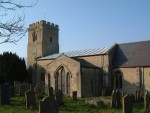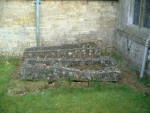theBythams
| history
: a walk through the archaeology of Castle Bytham : st james
church added 27/07/04 Our walk begins at the church of St James on the southern slopes of the valley of the River Tham that runs through Castle Bytham. Like many English parish churches it occupies a commanding position above the village emphasising the centrality of the Christian church over the past 1000 years of this country's life. In medieval England the church's dominance of society was shared with the political ruling class. Often in medieval settlements we see the dominance of the church buildings is mirrored by an equally imposing castle or manor house. Examples in Lincolnshire include Lincoln, Tattershall and Castle Bytham. The earliest dateable feature of the church is the north arcade, which is in the Transitional Norman style of about 1200 placing its construction during the tenancy in the village of William de Colvile. Much rebuilding of the church can be seen to have taken place during the mid 14th century. During this period there was a great increase in the number of foundations of chantries as the rich sought to guarantee the passage of their souls into heaven by the saying of prayers for their souls at specially designated altars often within churches. This may have been of particular concern to the heiress of the Colvile line and would have been a factor in the granting of £10 by Lady Alice Basset to the church to heighten the tower and to furnish it with bells and 100 shillings for the establishment of a chantry chapel in the north transept. Before leaving the churchyard look for the two medieval stone coffins just outside the porch, and the stone built house just to the east known as 'The Priory'. The central open hall of this building dates to the mid 15th century and internally the roof timbers still retain timbers blackened with soot from the open central hearth. 
View of St James Church, Castle Bytham (March 2003) 
Medieval stone coffins outside St James Church, Castle Bytham (March 2003) CLICK HERE to continue your Walk |

Heritage Lincolnshire is an independent charitable trust working to promote and enhance Lincolnshire's rich heritage for the benefit of local people and visitors. The Trust is supported by County and District Councils, national heritage bodies and through commercial activities and sponsorship. Acknowledgment ... The text shown on this page has been reproduced from a booklet written by Dan Ratcliffe, from the Heritage Trust of Lincolnshire, to accompany a walk around the village of Castle Bytham which he led as part of the Midsummer Fair in June 2004. We are grateful for their permission to reproduce the document on this website. |
